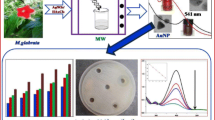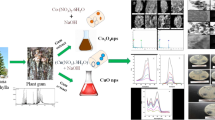Abstract
In this work, we are proposing the green synthesis of gold nanoparticles (AuNPs) using aqueous extracts of A. triphylla and evaluating their antibacterial and catalytic properties. Characterization was performed by UV–Vis and FT-IR spectroscopies, X-ray diffraction, and transmission electron microscopy (TEM). Antibacterial activity of AuNPs was analyzed using E. coli and S. Aureus and catalytic activity was determined by the degradation of methylene blue and congo red. UV–Vis analysis showed an increase in AuNPs concentration by increasing the extract concentration, volume extract, and precursor salt concentration. The crystalline nature of AuNPs was corroborated by X-ray diffraction. TEM analysis showed nanoparticles with spherical morphology (mostly) and size between 40 and 60 nm. These results are novel because they showed a homogeneous morphology and a narrow size distribution which is difficult to obtain in green synthesis processes. Results of antibacterial activity showed inhibition zones of 11.3 mm and 10.6 mm for S. Aureus and E. coli, respectively, indicating the bactericidal capacity of the nanoparticles. The degradation periods for methylene blue and congo red were 5 and 11 min, respectively, which are very short compared with previous reports. These results are of great significance for catalytic applications. Therefore, A. triphylla extracts made possible AuNPs synthesis and the nanoparticles obtained can be used as catalytic and antibacterial materials for water remediation.







Similar content being viewed by others
References
Ahmad T, Bustam MA, Irfan M, Moniruzzaman M, Asghar HMA, Bhattacharjee S (2017) Green synthesis of stabilized spherical shaped gold nanoparticles using novel aqueous Elaeis guineensis (Oil Palm) leaves extract. J Mol Struct 1159:167–173
alias Antonysamy MJ, Santhanam A, Thangaiah S, Narayanan J, (2017) Green synthesis of silver nanoparticles using Cyathea nilgirensis Holttum and their cytotoxic and phytotoxic potentials. Part Sci Technol 36:578–582. https://doi.org/10.1080/02726351.2016.1278292
Altaf M, Jaganyi D (2016) Characterization of triangular gold nanoparticles using Aloe arborescens leaf extract: a green synthesis approach. Synth React Inorg Met-Org Nano-Metal Chem 46:1332–1335. https://doi.org/10.1080/15533174.2015.1068810
Bhatt CS, Nagaraj B, Suresh AK (2017) Nanoparticles-shape influenced high-efficient degradation of dyes: comparative evaluation of nano-cubes vs nano-rods vs nano-spheres. J Mol Liq 242:958–965
Carmona ER, Benito N, Plaza T, Recio-Sánchez G (2017) Green synthesis of silver nanoparticles by using leaf extracts from the endemic Buddleja globosa hope green chemistry. Lett Rev 10:250–256. https://doi.org/10.1080/17518253.2017.1360400
Carnat A, Carnat AP, Fraisse D, Lamaison JL (1999) The aromatic and polyphenolic composition of lemon verbena. Tea Fitoter 70:44–49. https://doi.org/10.1016/S0367-326X(98)00016-1
Choudhary BC, Paul D, Gupta T, Tetgure SR, Garole VJ, Borse AU, Garole DJ (2017) Photocatalytic reduction of organic pollutant under visible light by green route synthesized gold nanoparticles. J Environ Sci 55:236–246
Deepak P, Sowmiya R, Balasubramani G, Aiswarya D, Arul D, Josebin MPD, Perumal P (2017) Mosquito-larvicidal efficacy of gold nanoparticles synthesized from the seaweed, Turbinaria ornata (Turner) J. Agardh 1848. Part Sci Technol 36:974–980. https://doi.org/10.1080/02726351.2017.1331286
Desai MP, Sangaokar GM, Pawar KD (2018) Kokum fruit mediated biogenic gold nanoparticles with photoluminescent, photocatalytic and antioxidant activities. Process Biochem 70:188–197
Dhamecha D, Jalalpure S, Jadhav K, Sajjan D (2016) Green synthesis of gold nanoparticles using Pterocarpus marsupium: characterization and biocompatibility studies Particulate. Sci Technol 34:156–164. https://doi.org/10.1080/02726351.2015.1054972
Dhayalan M, Denison MIJ, Ayyar M, Gandhi NN, Krishnan K, Abdulhadi B (2018) Biogenic synthesis, characterization of gold and silver nanoparticles from Coleus forskohlii and their clinical importance. J Photochem Photobiol B 183:251–257
Emmanuel R, Karuppiah C, Chen S-M, Palanisamy S, Padmavathy S, Prakash P (2014) Green synthesis of gold nanoparticles for trace level detection of a hazardous pollutant (nitrobenzene) causing Methemoglobinaemia. J Hazard Mater 279:117–124
Fathima JB, Pugazhendhi A, Oves M, Venis R (2018) Synthesis of eco-friendly copper nanoparticles for augmentation of catalytic degradation of organic dyes. J Mol Liq 260:1–8
Gangapuram BR, Bandi R, Madhusudhan A, Dadigala R, Kotu GM, Guttena V (2018) Microwave assisted rapid green synthesis of gold nanoparticles using Annona squamosa L peel extract for the efficient catalytic reduction of organic pollutants. J Mol Struct 1167:305–315
Geethalakshmi R, Sarada D (2013) Characterization and antimicrobial activity of gold and silver nanoparticles synthesized using saponin isolated from Trianthema decandra L. Ind Crops Prod 51:107–115
Hamelian M, Varmira K, Veisi H (2018) Green synthesis and characterizations of gold nanoparticles using thyme and survey cytotoxic effect, antibacterial and antioxidant potential. J Photochem Photobiol B 184:71–79
Jyoti K, Singh A (2016) Green synthesis of nanostructured silver particles and their catalytic application in dye degradation. Genet Eng Biotechnol 14:311–317
Keshavamurthy M, Srinath BS, Rai VR (2018) Phytochemicals-mediated green synthesis of gold nanoparticles using Pterocarpus santalinus L. (Red Sanders) bark extract and their antimicrobial properties Part Sci Technol 36:785–790. https://doi.org/10.1080/02726351.2017.1302533
Krishna IM, Reddy GB, Veerabhadram G, Madhusudhan A (2016) Eco-friendly green synthesis of silver nanoparticles using Salmalia malabarica: synthesis, characterization, antimicrobial, and catalytic activity studies. Appl Nanosci 6:681–689
LaMer VK, Dinegar RH (1950) Theory, production and mechanism of formation of monodispersed hydrosols. J Am Chem Soc 72:4847–4854
Lopes C, Courrol L (2018) Green synthesis of silver nanoparticles with extract of Mimusops coriacea and light. J Lumin 199:183–187
López-Miranda JL, Borjas-Garcia S, Esparza R, Rosas G (2016) Synthesis and catalytic evaluation of silver nanoparticles synthesized with Aloysia triphylla leaf extract. J Cluster Sci 27:1989–1999
Manjunath HM, Joshi CG, Raju NG (2016) Biofabrication of gold nanoparticles using marine endophytic fungus–Penicillium citrinum. IET nanobiotechnol 11:40–44
Mishra A, Kumari M, Pandey S, Chaudhry V, Gupta K, Nautiyal C (2014) Biocatalytic and antimicrobial activities of gold nanoparticles synthesized by Trichoderma sp. Bioresour Technol 166:235–242
Mythili R et al (2018) Biogenic synthesis, characterization and antibacterial activity of gold nanoparticles synthesised from vegetable waste. J Mol Liq 262:318–321
Nadaf NY, Kanase SS (2016) Biosynthesis of gold nanoparticles by Bacillus marisflavi and its potential in catalytic dye degradation. Arab J Chem. https://doi.org/10.1016/j.arabjc.2016.09.020
Nadeem M, Abbasi BH, Younas M, Ahmad W, Khan T (2017) A review of the green syntheses and anti-microbial applications of gold nanoparticles. Green Chem Lett Rev 10:216–227. https://doi.org/10.1080/17518253.2017.1349192
Parial D, Patra HK, Dasgupta AKR, Pal R (2012) Screening of different algae for green synthesis of gold nanoparticles European. J Phycol 47:22–29. https://doi.org/10.1080/09670262.2011.653406
Pasca R-D, Mocanu A, Cobzac S-C, Petean I, Horovitz O, Tomoaia-Cotisel M (2014) Biogenic syntheses of gold nanoparticles using plant extracts particulate. Sci Technol 32:131–137. https://doi.org/10.1080/02726351.2013.839589
Patra JK, Kwon Y, Baek K-H (2016) Green biosynthesis of gold nanoparticles by onion peel extract: Synthesis, characterization and biological activities. Adv Powder Technol 27:2204–2213
Pourmortazavi SM, Taghdiri M, Makari V, Rahimi-Nasrabadi M, Batooli H (2017) Reducing power of Eucalyptus oleosa leaf extracts and green synthesis of gold nanoparticles using the extract international. J Food Prop 20:1097–1103. https://doi.org/10.1080/10942912.2016.1203334
Rajan A, Rajan AR, Philip D (2017) Elettaria cardamomum seed mediated rapid synthesis of gold nanoparticles and its biological activities. OpenNano 2:1–8
Rajkumari J, Meena H, Gangatharan M, Busi S (2017) Green synthesis of anisotropic gold nanoparticles using hordenine and their antibiofilm efficacy against Pseudomonas aeruginosa. IET Nanobiotechnology 11:987–994
Rasheed T, Bilal M, Li C, Nabeel F, Khalid M, Iqbal HM (2018) Catalytic potential of bio-synthesized silver nanoparticles using Convolvulus arvensis extract for the degradation of environmental pollutants. J Photochem Photobiol B 181:44–52
Salem MA, Bakr EA, El-Attar HG (2018) Pt@ Ag and Pd@ Ag core/shell nanoparticles for catalytic degradation of Congo red in aqueous solution. Spectrochim Acta Part A Mol Biomol Spectrosc 188:155–163
Sana SS, Dogiparthi LK (2018) Green synthesis of silver nanoparticles using Givotia moluccana leaf extract and evaluation of their antimicrobial activity. Mater Lett 226:47–51
Saravanan C, Rajesh R, Kaviarasan T, Muthukumar K, Kavitake D, Shetty PH (2017) Synthesis of silver nanoparticles using bacterial exopolysaccharide and its application for degradation of azo-dyes. Biotechnol Rep 15:33–40
Sengan M, Veeramuthu D, Veerappan A (2018) Photosynthesis of silver nanoparticles using Durio zibethinus aqueous extract and its application in catalytic reduction of nitroaromatics, degradation of hazardous dyes and selective colorimetric sensing of mercury ions. Mater Res Bull 100:386–393
Shanker U, Jassal V, Rani M, Kaith BS (2016) Towards green synthesis of nanoparticles: from bio-assisted sources to benign solvents. Rev Int J Environ Anal Chem 96:801–835. https://doi.org/10.1080/03067319.2016.1209663
Singh P, Kim Y-J, Zhang D, Yang D-C (2016) Biological synthesis of nanoparticles from plants and microorganisms. Trends Biotechnol 34:588–599. https://doi.org/10.1016/j.tibtech.2016.02.006
Singh J, Kukkar P, Sammi H, Rawat M, Singh G, Kukkar D (2017) Enhanced catalytic reduction of 4-nitrophenol and congo red dye By silver nanoparticles prepared from Azadirachta indica leaf extract under direct sunlight exposure. Part Sci Technol:1–10. https://doi.org/10.1080/02726351.2017.1390512
Suganya KU, Govindaraju K, Kumar VG, Dhas TS, Karthick V, Singaravelu G, Elanchezhiyan M (2015) Blue green alga mediated synthesis of gold nanoparticles and its antibacterial efficacy against gram positive organisms. Mater Sci Eng C 47:351–356
Teimouri M, Khosravi-Nejad F, Attar F, Saboury AA, Kostova I, Benelli G, Falahati M (2018) Gold nanoparticles fabrication by plant extracts: synthesis, characterization, degradation of 4-nitrophenol from industrial wastewater, and insecticidal activity—a review. J Clean Prod 184:740–753. https://doi.org/10.1016/j.jclepro.2018.02.268
Umamaheswari C, Lakshmanan A, Nagarajan N (2018) Green synthesis, characterization and catalytic degradation studies of gold nanoparticles against congo red and methyl orange. J Photochem Photobiol B 178:33–39
Vidhu V, Philip D (2014) Catalytic degradation of organic dyes using biosynthesized silver nanoparticles. Micron 56:54–62
Vijayaraghavan K, Ashokkumar T (2017) Plant-mediated biosynthesis of metallic nanoparticles: A review of literature, factors affecting synthesis. Charact Tech Appl J Environ Chem Eng 5:4866–4883. https://doi.org/10.1016/j.jece.2017.09.026
Wang L, Lu F, Liu Y, Wu Y, Wu Z (2018) Photocatalytic degradation of organic dyes and antimicrobial activity of silver nanoparticles fast synthesized by flavonoids fraction of Psidium guajava L. leaves. J Mol Liq 263:187–192
Yuan C-G, Huo C, Gui B, Cao W-P (2016) Green synthesis of gold nanoparticles using Citrus maxima peel extract and their catalytic/antibacterial activities. IET Nanobiotechnol 11:523–530
Zamorano-Ponce E et al (2006) Anti-genotoxic effect of Aloysia triphylla infusion against acrylamide-induced DNA damage as shown by the comet assay technique. Mutat Res/Genet Toxicol Environ Mutagenesis 603:145–150. https://doi.org/10.1016/j.mrgentox.2005.11.009
Zhou R, Srinivasan M (2015) Photocatalysis in a packed bed: degradation of organic dyes by immobilized silver nanoparticles. J Environ Chem Eng 3:609–616
Acknowledgements
The authors would like to acknowledge to the Laboratorio Nacional de Caracterización de Materiales (LaNCaM) at the CFATA–UNAM. Authors acknowledge to J. A. Cervantes-Chávez from Universidad Autónoma de Querétaro for the support in the antibacterial study reported in the present work. The authors are grateful to Ana L. Ramos-Jacques for her comments in proofreading the final manuscript.
Author information
Authors and Affiliations
Corresponding author
Ethics declarations
Conflict of interest
On behalf of all the authors, the corresponding author states that there is no conflict of interest.
Rights and permissions
About this article
Cite this article
López-Miranda, J.L., Esparza, R., Rosas, G. et al. Catalytic and antibacterial properties of gold nanoparticles synthesized by a green approach for bioremediation applications. 3 Biotech 9, 135 (2019). https://doi.org/10.1007/s13205-019-1666-z
Received:
Accepted:
Published:
DOI: https://doi.org/10.1007/s13205-019-1666-z




